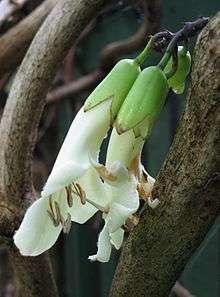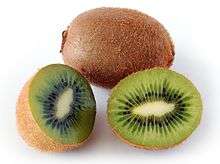Flora of New Zealand
This article relates to the flora of New Zealand, especially indigenous strains. New Zealand's geographical isolation has meant the country has developed a unique variety of native flora. However, human migration has led to the importation of many other plants (generally referred to as 'exotics' in New Zealand) as well as widespread damage to the indigenous flora, especially after the advent of European colonisation, due to the combined efforts of farmers and specialised societies dedicated to importing European plants & animals.

Characteristics
Indigenous New Zealand flora generally has the following characteristics:[1]
- the majority are evergreen.
- few annual herbs.
- few cold-tolerant trees.
- majority are dispersed by birds.
- very few have defences against mammalian browsers.
- few nitrogen fixing plants.
- few fire-adapted species.
- many dioecious species.
- flowers are typically small and white.
- many plants have divaricating growth forms.
- many plants have evolved into larger forms compared with similar plant families in other countries.
List of plants
Trees and shrubs
|
|
|
Ferns
While most of the world's ferns grow in tropical climates, New Zealand hosts an unusual number of ferns for a temperate country. These exhibit a variety of forms, from stereotypical feather-shaped tufted ferns and tree ferns to less typical filmy, leafy and climbing ferns. Both the koru, in the shape of an unfurling fern frond, and the silver fern are widely accepted symbols of New Zealand.
New Zealand has ten species of tree ferns,[2] but there are numerous ground, climbing and perching smaller ferns to be found throughout the countries forests, the largest of which is the king fern.[3]
- Silver fern or ponga, Cyathea dealbata
- New Zealand tree fern, Dicksonia squarrosa
- Black tree fern or mamaku, Cyathea medullaris
- Tuokura, Dicksonia lanata
- Kuripaka, Dicksonia fibrosa
- Mountain tree fern, Cyathea colensoi
- Gully tree fern, Cyathea cunninghamii
- Soft tree fern, Cyathea smithii
- King fern, Ptisana salicina
- Prince of Wales fern, Leptopteris superba
- Hound's tongue fern, Microsorum pustulatum
- Kidney fern or raurenga, Trichomanes reniforme
- Hen and chickens fern, Asplenium bulbiferum
- Hanging spleenwort, Asplenium flaccidum
- Mangemange, Lygodium articulatum
Seaweeds
- Neptune's necklace
Liverworts
New Zealand has a greater density of liverworts than any other country, due to its cool, wet and temperate climate. About half the species are endemic to New Zealand.
There are 606 species known in New Zealand. While these include some thallose liverworts, with liver-shaped thalli, most are leafy liverworts which can be confused with mosses and filmy ferns. Undescribed species, and those not previously recorded in New Zealand, continue to be found in lowland forests. Ninety species and varieties are listed on the 2001 Department of Conservation threatened plants list, and 157 liverwort species and varieties will be included on the next version of the list as a result of better knowledge of the group.
A three-volume work on liverworts in New Zealand is being written by John Engel and David Glenny, with the first volume published in 2008.[4] The first volume will also be placed online in June 2009 as part of Floraseries.[5]
Grasses
There are 187 species of native grasses in New Zealand: 157 endemic and 30 indigenous species.[6]
The grasses belong to the following tribes and genera:
|
|
Mosses
There are 523 known moss species and 23 varieties in New Zealand, with 208 genera represented. 108 species and 11 genera are considered endemic. Most New Zealand mosses originated in Gondwana, so there are strong relationships with species in Tasmania, South-eastern Australia, and temperate parts of South America.[7] The endemic genera are:
|
|
|
Sphagnum moss is also of economic importance.
Other

- Bush lawyer
- Celmisia (Mountain Daisy)
- Megaherbs
- Nine species of mistletoe, including Peraxilla colensoi, Peraxilla tetrapetala, Alepis flavida, and the extinct Trilepidea adamsii (last seen in 1954).
- Mount Cook Lily
- New Zealand flax
- New Zealand spinach (Kokihi)
- Nikau Palm
- Pingao
- Raupō or bulrush
- Supplejack
- Tecomanthe speciosa
- Wood rose
Cultural significance
| Title | Symbol | Picture |
|---|---|---|
| National tree | Silver fern (Cyathea dealbata) |  |
| National flowers | Kōwhai (Sophora tetraptera) Pōhutukawa (Metrosideros excelsa) "Floral Emblems of Aotearoa" |  |
| National fruit | Kiwifruit (Actinidia deliciosa) |  |
| National vegetable | Beetroot (Beta vulgaris maritima) | .jpg) |
| National crops | Oats (Avena sativa) Potato (Solanum tuberosum) |   |
See also
References
- http://www.bushmansfriend.co.nz/nz-native-plant-features-xidc13127.html
- "Number of Tree Ferns Reference".
- "King Fern largest ground fern. Page 19" (PDF).
- Engel, J. J. and Glenny, D. 2008 A flora of the liverworts and hornworts of New Zealand. Monographs in systematic botany volume 110, Missouri Botanic Gardens Press, Missouri.
- David Glenny, New Zealand's liverworts, no longer a forgotten group, Te Taiao, Number 6, July 2006, ISSN 1176-2454
- H. E. Connor and E. Edgar. "History of the taxonomy of the New Zealand native grass flora". Retrieved 20 August 2006.
- Landcare Research. "Characteristics of the Indigenous Moss Flora". Retrieved 20 August 2006.
External links
- Ford, K. A. (2014). "Centrolepidaceae. In: Breitwieser, I.; Brownsey, P.J.; Heenan, P.B.; Wilton, A.D. Flora of New Zealand — Seed Plants. Fascicle 2". Flora of New Zealand. Retrieved 2 September 2014.
- http://www.nzflora.info/index.html - Flora of New Zealand
- "Recovery plan for threatened grassy plants of dry fertile sites, 2003–2013. C. Jones (Threatened Species Recovery Plan 52)" (PDF). [Department of Conservation, Wellington, New Zealand. 2004. Retrieved 19 September 2007.
- Royal New Zealand Institute of Horticulture. Lincoln University, Canterbury, New Zealand.
- New Zealand Plant Names Database
- Bushmansfriend:NZ native plant information
- New Zealand Plant Conservation Network
- http://www.landcareresearch.co.nz/resources/identification/plants/grass-key (a Lucid key to naturalised and indigenous grasses of New Zealand)
- Native New Zealand Plants, University of Auckland
